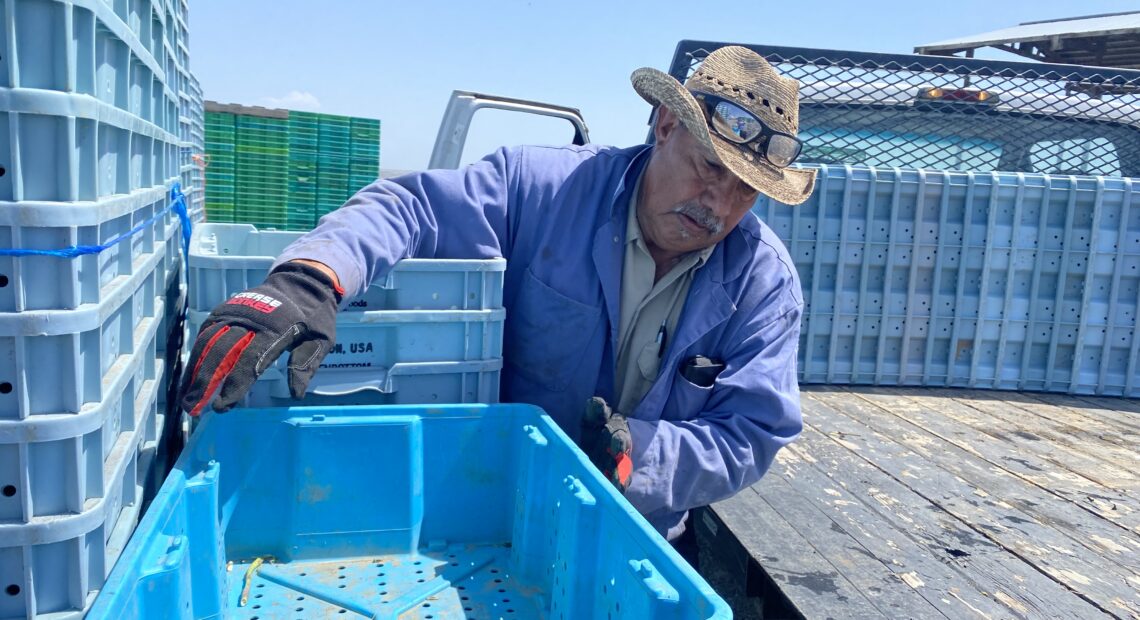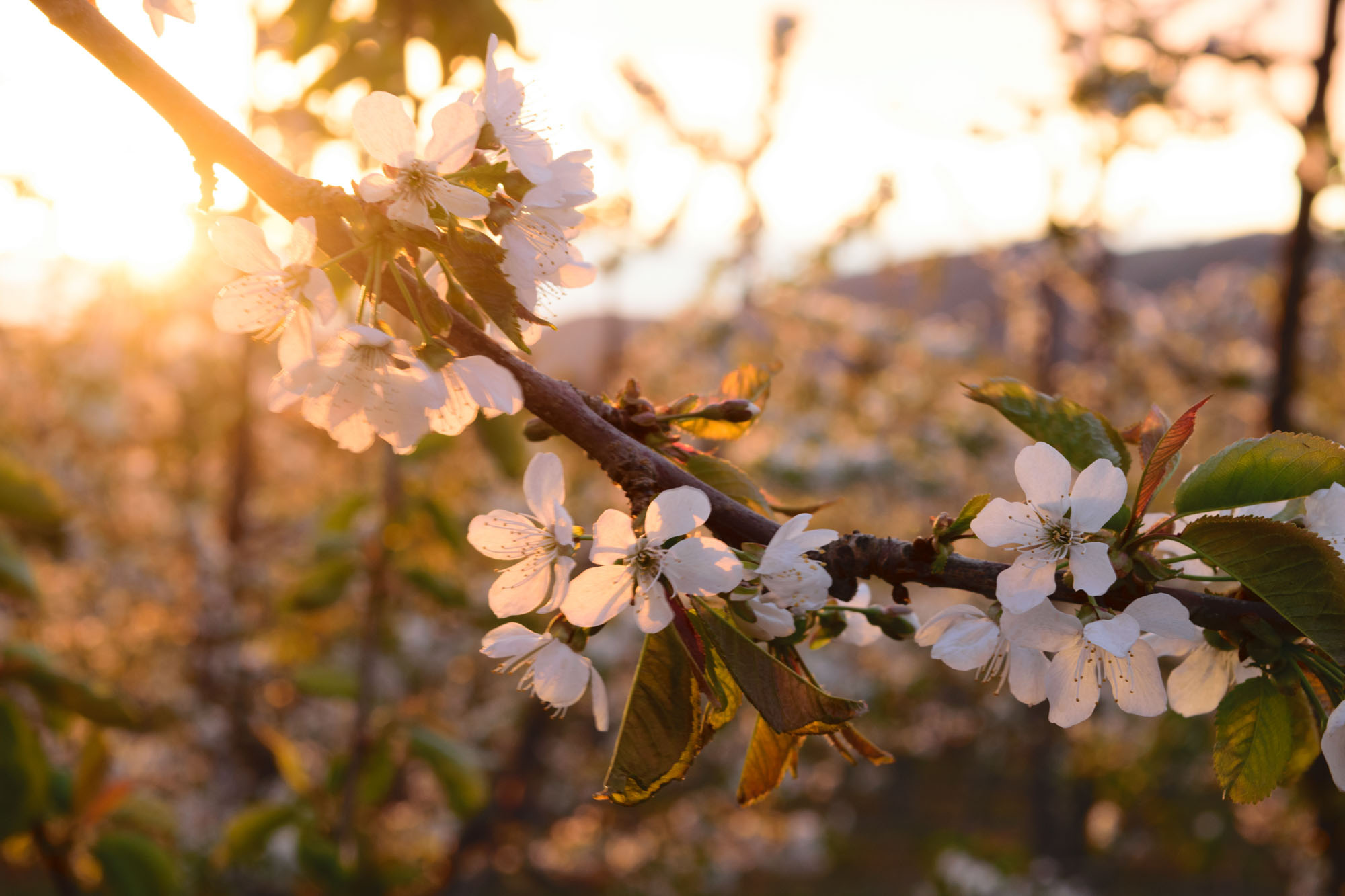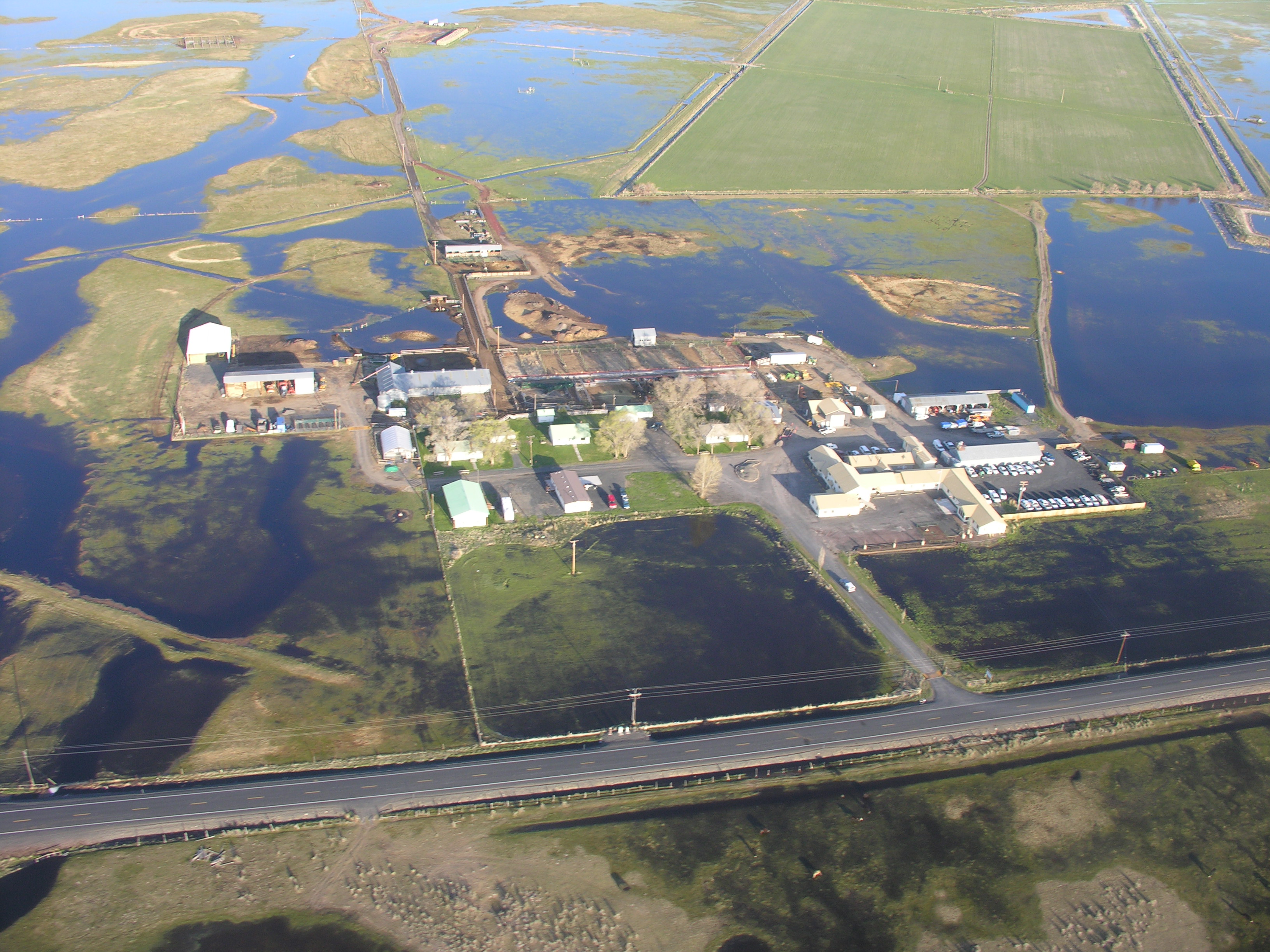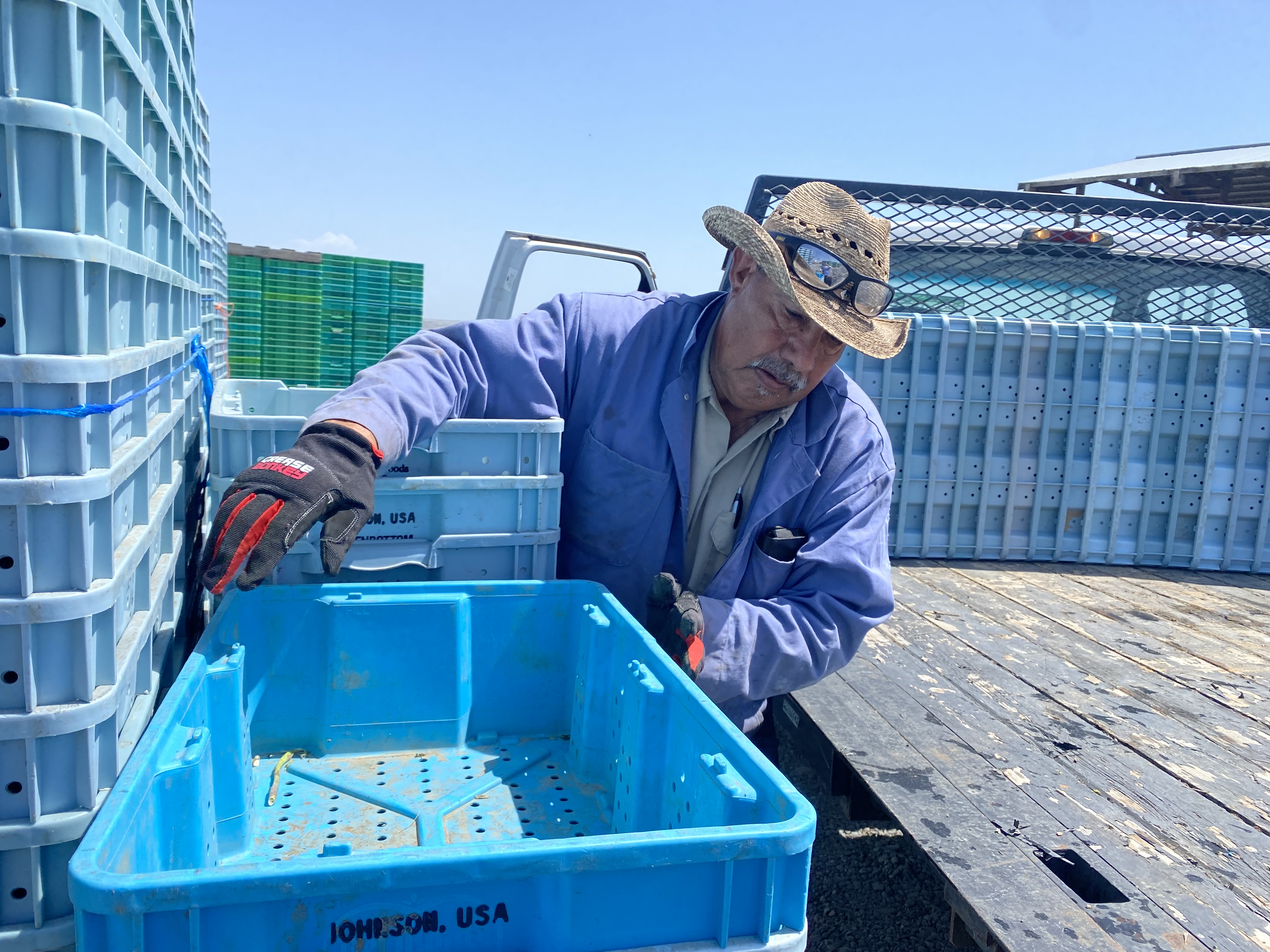
Spring push: Long cool spring, then record warm weather sends Northwest farmers scrambling
Read
Celestino Mendoza loads colorful plastic asparagus lugs off the flatbed of a ’95 Ford pickup at the end of a warm day.
His woven straw hat shades his face, but a smile flashes through the shadow when asked if the heat has meant a lot of work.
“I’m ready to go home,” he chuckles softly.
Work has been heavy at this farm north of Pasco for around a week now, especially since a burst of asparagus came in with the record high weekend temperatures that hit some areas of the Northwest.
Asparagus pushes out of the ground from their crowns when the soil temperature reaches above 50 degrees Fahrenheit.
This recent burst of work – and so much asparagus, farmers call it “grass” – was a surprise. It’s been so cold this spring that for one of Washington asparagus farmers’ top-selling holidays – Easter – they didn’t have any to cut. They’re hoping Mother’s Day will make up for some of the lost sales.
For soil temperatures to go from 49 to 56 degrees in a week is like a race car quickly accelerating from zero to 60 miles an hour. And the about-face in weather creates a mix of bad and good for agriculture across the Northwest: Washington and Oregon growers are racing to protect their apples and pears from fire blight – a bacteria that spreads easily in warm, moist conditions and can kill trees. Meanwhile, in southeast Oregon, ranchers are moving cattle to higher ground as meltwater floods down from the snow-packed mountains.
The ‘grass’
Gary Larsen, the owner of a roughly 95-acre asparagus farm north of Pasco, said he’s been getting up at 4 a.m. this past week.
“It’s a good problem, but it puts a lot of pressure on ya,” Larsen said. “Do you have enough boxes? Do you have enough trucks? Are your workers gonna make it? You get through the day and celebrate at the end – ‘Yeah, we made it!’ And then you have the next day to feel all those emotions again. Do we have enough boxes? Are the workers going to show up?”
The workers start picking at 3 a.m., he said, to beat the heat of the day. They bend low to the ground with a knife and have to decide in seconds which spears to cut, which ones to leave to grow more the next day and which are damaged enough to trash.
“Without those workers, there wouldn’t be an asparagus industry anywhere,” Larsen said.
In just a few days, Larsen’s crew of 60 workers cut 195,000 pounds of asparagus. That’s a semi truck load, plus an additional, smaller trailer pulling out of the farm every day, he said.
“I was very happy,” Larsen said about the grass tally. “That took care of a lot of payroll.”

Cherry blossoms at sunrise on a central Washington farm. (Courtesy: Stemilt)
Bloom boom, late bings and blight
But the warmer weather during bloom season has also caused some complications. This year, the cool spring and then the flush of rapid warm weather has meant trees are blossoming across Washington and Oregon nearly all at once. Typically, warmer areas bloom first, then cooler and higher-elevation areas bloom weeks later.
So this year’s flip-of-a-switch conditions have created a bloom boom, of sorts.
Robin Graham is a manager at Stemilt Growers, one of the largest cherry-growing operations in the United States. He said the bloom this year has been rapid. But overall, the cooler weather may delay Bing and Rainier cherries about 15 days from usual harvest times to mid-June.
“There’s sort of a joke in agriculture,” Graham said. “No year feels ideal from a farming standpoint.”
But he said there’s been a pattern over the last few years. February is fairly warm – a false spring – then, a cool period reaches out and delays development of the fruit trees into the real spring.
“It pushes bloom out in a more condensed fashion,” Graham said. “When we have these types of area-wide rapid increases in temperature, bloom tends to condense together.”
He said that can affect the marketing of the cherries – because all the fruit will come closer together than having a wider spread across the calendar. And there may be less time for consumers to consume those sweet orbs.
Meanwhile, the combination of recent warmer weather, open blossoms and expected rain is prompting a flurry of activity in many apple and pear orchards in central Washington.
Tianna DuPont is a Washington State University Extension specialist based in Wenatchee. She studies bacteria that infect fruit trees called fire blight – and she said this spring could be fairly described as “scary.”
She said the blight infects pear and apple trees through the open blossoms before spreading to branches, or many times the entire tree – sometimes killing it. It can be spread through pruning and pollen and farmers don’t have great tools to fight it.
“We have extreme fire blight risk, due to very high temperatures in the 80s, [and] multiple rain events when bloom is open in apples and pears all across the region,” DuPont said. “Growers have told me that this level of fire blight is creating a lot of concern – and growers are being very aggressive, because a bad fire blight infection risks their entire orchard.”
Dupont said farmers should keep an eye out starting in about a week and cut out any infected branches right away. Early symptoms include weakened and blackened flower clusters.
“You’re trying to get it early, before it goes through the entire tree,” she said.

Harney County is seeing significant spring runoff that is flooding hay meadows and causing ranchers to move cattle – but the extra water should result in a good hay production year. (Courtesy: Kristen Munday)
Cattle drive
Meanwhile, hundreds of cattle and their calves are being driven to their summer range in southeast Oregon.
David Bohnert is the director of Eastern Oregon Agricultural Research Center, out of Burns.
He said the research center moved its nearly 250 cattle last week, a few weeks later than normal. Summer range hasn’t been greening up because of all the spring snow. Now, ranch managers are worried about possible flooding in the lowland meadows from the massive snow pack that has accumulated in the mountains.
Near Burns, the Silvies River was flowing at 300 percent of normal last week. Dally Swindlehurst is the state watermaster for District 10, in southeast Oregon.
“It’s flowing pretty good,” he said of the Silvies. “Right now we’re flowing at 2,760 CFS [cubic feet per second] and last year I had one day that was over 400. Down toward [Malheur Lake] they are starting to get their water too [at the federal refuge for migratory birds]. It’s just taking a long time because the ground is so dry.”
Cattle, Bohnert said, can usually deal with a bit of water, but there is nothing for them to eat with flooding covering any available grass, and the young calves have a harder time.
But the good news: watering holes for cattle have filled up, Bonhert said.
“Now we just need to make sure we have enough precip — some rain basically — in order to grow that forage to take advantage of that water and the grass.”
He said well-timed rains in the spring produce better grass for the cattle on the range throughout the summer. And he said even with the snowpack in the higher elevations — with the drought last year, lack of rain so far this year, and the wind – the soils are drying out faster than expected.
“Most of the range grass we get is from the rains we get in April and May,” Bohnert said. “That’s why it’s really critical for us to get both. We need the snowpack for our spring meadows, but we need the spring rains for our rangeland.”
Lots of crops are affected by the fluctuating conditions. Potatoes, alfalfa and wine grapes are still more than a week behind. And beekeepers are also scrambling with so many fruit trees blooming at once.
Spring and summer are always busy, and the weather is never predictable. But farmers are hoping for an easy entry into summer. As Drex Gauntt, an alfalfa and vegetable grower in Burbank, Wash. put it: “One week of sunshine makes it a lot easier to be optimistic.”
















